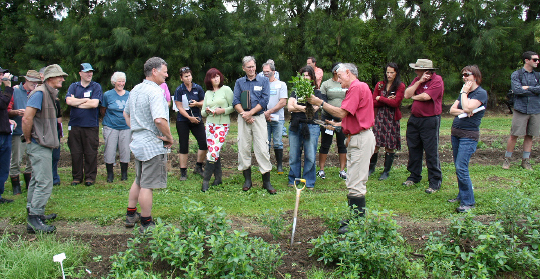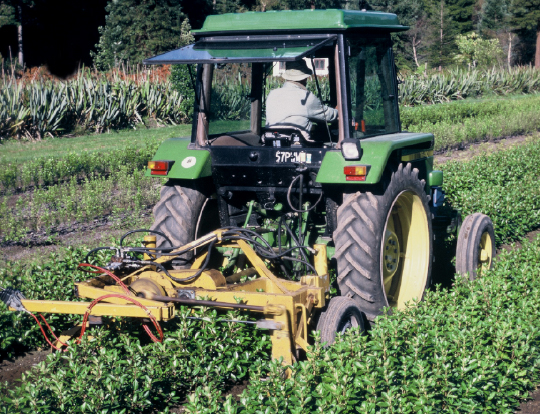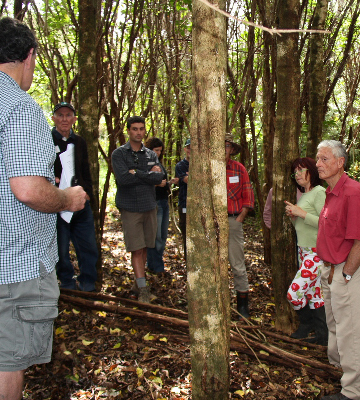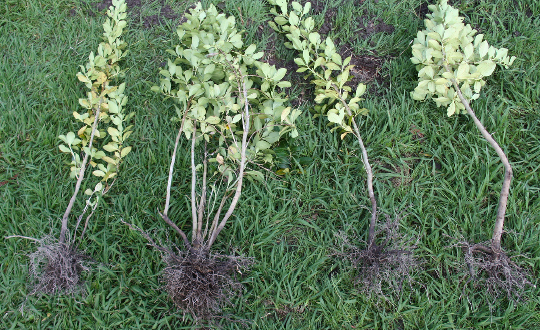Not perfect but a field day and a half

Open-Ground Open Day: Jaap van Dorsser demonstrating the degree of root pruning required by open-ground plants. In the foreground, indigenous plants display growth rate typical after spending just two months in open-ground beds. photographer Michael Bergin
The preceding two days’ weather had precipitated a trickle of apologies.
However the day dawned as fine as the forecast charts, stemming what otherwise might have become a flood of cancellations, and vindicating the decision to charter a bus. With the relief that followed came reflection that the need to introduce people to open-ground is an on-going one, and that the excursion itself could usefully be considered as a trial.
Filling a 12-seater from time to time will be a much easier proposition than filling a 30-seater, and there is much less at stake should extreme weather—such as that which struck the day before, or some other eventuality—force a cancellation. The obvious downside of self-drive is that the driver is excluded from the rich discussions, which began even before the bus was boarded in Warkworth.
The inaugural field day was held in 2008, at Taupō Native Plant Nursery’s main nursery in Taupō. The plants that were inspected in their open-ground beds, that rainy June day, were soon to be lifted and established in the first-ever scientifically designed trials, in the Mahurangi catchment—the subject of the half-day, of the day-and-a-half field day. That was not the only major milestone of that occasion. The canny chief executive of Lake Taupō Protection Trust, Graeme Fleming, had got wind of the field day and attended. In exploring land use alternatives to grazing that would reduce the nitrogen leaching into the catchment—threatening the long-term health of the North Island’s iconic lake—Fleming had discovered that the high cost of establishing indigenous forestry was marginalising that option. The outcome was a three-year, $150 000, trial in the Taupō catchment that furthers and expands the Mahurangi–Weiti work.
Since then, Taupō Native Plant Nursery has progressed its long-term strategy of meeting the burgeoning demand for indigenous plants in the Auckland region, establishing a northern nursery with space for open-ground production, making the road trip to view open-ground nursery beds, and back, nearly 500 kilometres shorter. Having said that, the target return time of 4.30 pm at Warkworth was missed by 30 minutes, suggesting that organisers were too accommodating when the discussion strayed off-topic for too long—had motorway traffic been heavier, some attendees could have been seriously inconvenienced.

Serious Indigenous Forestry Setback: Having successfully adapted forestry nursery methods to raising indigenous plants and trees in the late 1960s, this pioneering work was curtailed in favour of radiata pine. The field day would have been even better if a demonstration of the undercutterwrencher, as could be routinely provided at the Forest Research Institute nursery, before it was compelled to abandon work on indigenous species. photographer Jonathan Barran
Whereas the open-ground beds in the Taupō nursery are well established, those at Glenbrook have been freshly formed. And in contrast to the lush and even grow rates experienced at Taupō, the Glenbrook plants are quite uneven, with some severely stunted. The nursery’s chief suspect is simazine—the open-ground beds coincide exactly where rows of fruit trees stood until recently, and the pre-emergent herbicide is commonly used to suppress vegetation beyond the ready reach of orchard mowers. This setback is ironic in that Taupō Native Plant Nursery has found that, in contrast to those container-grown, open-ground plants require little or no spraying with fungicidal chemicals.
Despite the spotty results, most specimens displayed a good rate of growth for the two months since being lined-out in their open-ground beds. The foliage of open-ground plants, unlike their closely spaced container-raised counterparts, has room to develop laterally, not just vertically. A more graphic way of illustrating this would have been to arrange a selection of container-raised plants immediately alongside the open-ground beds. The lateral space allowed each Hillson-sized root trainer plant is some 10% of that enjoyed by open-ground plants spaced at 15 centimetre centres. Small wonder then that root trainer –raised plants grow thin and wispy, and even PB3-sized have only 44% the space of open-ground plants. But the space is important not just producing squat and sturdy plants. The foliage, as Jaap van Dorsser will readily remind, is the engine room of the plant—it is what will drive growth when the specimen is transplanted to its permanent home.
While foliage drives a plant’s growth, the open-ground method focuses closely on root systems on which plants will ultimately depend, not merely for moisture and minerals, but to hold their engine-room canopies aloft. In situ root pruning and wrenching, in most plants, stimulates the development of a compact root system, necessary for successful transplantation. While this traditionally was done by hand using a sharp spade, the needs of forestry, and large-scale restoration planting are meet by tractor-drawn machinery. Non-dished, surgical stainless steel discs (coulters) are run between the rows to cut lateral roots, and an undercutter consisting of a narrow reciprocating blade slices the vertical roots. The roots of some species receive a second lateral cut across the row by hand—box cutting—where the additional encouragement to form a compact fibrous root mass is required.
The undercutter, fitted with a broader and slightly angled blade, also does service periodically wrenching plants, including immediately prior to their being harvested—lifted. Continuing the ‘even better if’ theme, such field days should include a demonstration of the undercutter–wrencher at work. Plans to at least have the machinery onsite were interrupted when the gale that swept south last Tuesday caused considerable damage to the Taupō nursery. In the event, attendees must be grateful that manager Philip Smith took time out from overseeing repairs there to travel to Glenbrook.
When lifted, any remaining longer roots are hand-trimmed—planting with such roots intact risks subsequent root strangulation or simply a lack of support, should the root become significant. Plants lack a mechanism for correcting roots that have been misdirected at the planting stage, or prior to it, where the constraints of a growing container have caused roots to circle.

Indigenous Forestry: Although distained by biodiversity zealots, indigenous forestry could add richly to the Aotearoa landscape that, for the most has been reduced to ryegrass and radiata. In this Waiau Pā nurse crop trial site planted by Dr David Bergin, left, pūriri is growing straight and tall—up to a metre per year. photographer Michael Bergin
The tour then transferred to the conventional container-based operations of the nursery, providing ‘catering corps’ with the opportunity to commence barbecuing at the nearby Glenbrook Hockey Club, aptly complete with locally contributed club sandwiches. The short animated video on the open-ground method narrated by Mya Cole served to launch the post luncheon discussion, with a round of applause. While sometimes ranging off topic, the discussion highlight was Dr David Bergin’s impassioned call for the need to become far more professional in order to realise the goal of large-scale establishment of indigenous species for multiple purposes.
Indigenous forestry is just one of those purposes, and one that is largely overshadowed by restoration planting. The reasons for this neglect are many but include high establishment cost, the perception of impossibly slow growth rates, and legal impediments to harvesting. The indigenous forestry nurse crop trial at Whiteciffs Reserve—6.8 kilometres north-northeast of the nursery, as the kererū flies, on the northern side of the tidal Taihiki River—addresses aspects of the first two issues. With the nurse species established by Dr Bergin 20 years ago and the target trees planted three and five years later, the growth rates of tōtara and pūriri in particular, give lie to the too-slow-to-be-commercial conventional wisdom—pūriri adding up to a centimetre in diameter, and a metre in height, per year. And for those who believe indigenous trees should only be planted for restoration purposes, the alternative prevailing near-monoculture of pasture is just metres away—the 1.3-hectare balance of the reserve, begging for more trials to be established.
With Jaap and David, the return bus journey gained two important passengers—the few spare seats nicely facilitating an invaluable fluidity of discussion groups. The fortunate few who dinned later at the Salty Dog were able to prolong exchange of knowledge and ideas.
Most had only registered for the first day—signing up people for a two-day field day is not an easy task. So it was a measure of the field day’s success that several more than had so indicated, attended, and nearly every available seat on the Parsley Pot Café’s veranda was needed. Starting a field day at a café is optimally functional, inviting the realisation that the Glenbrook nursery visit would have been even better if it had begun in similar fashion, possibly at the strategically placed Karaka Kitchen on Linwood Road. If there were lingering doubts as to whether mānuka in particular, with its famously sensitive roots, copes with being bare-rooted can be raised open-ground, they surely were assuaged. And although that the survival rate of that species was 1.3 percentage points down on the root trainer –raised plants, and 32.5 down on PB3-sized container–raised plants, it still came out ahead in the canopy spread stakes when adjusted for survival and cost—and Philip Smith has halved the cost of open-ground plants from the nominal rate charged when the trial was established four years ago.
Meantime, in an impressive display of record keeping, Michael Bergin identified the three karamū that were disinterred three years earlier, to the horror of the property holder, in order to determine how far afield the roots of open-ground and container-raised plants had ventured after a year in the ground. The examination revealed that in contrast to the open-ground specimen, the roots of neither of other two had ventured appreciably beyond the potting mix that demarked the limits of the container in which they were raised. While the three plants were all healthy, the temptation to repeat the experiment was resisted, in the interests of not re-traumatising them, or their owner.

Karamū Comparable: The root systems of the four karamū in the three-year-old Goodall Reserve trial disinterred on Friday were comparable except that one specimen, second from left, exhibited significant tightly circled roots close to its base. The malformation, which will probably cause that plant to fail sooner or later, was likely caused when the seedling outgrew the confines of its plug tray space. The stock types are, left to right, open-ground, Tinus root trainer, PB3-sized pot or planter bag, and Hillson root trainer. photographer Michael Bergin
There was not such apprehension at the next trial site, near the riparian margin of Goodall Reserve. Here four three year-old plants were dug up and bare-rooted and compared. However, after an extra two years in the ground the differences were not stark, with all four root systems having grown well beyond the potting media. The notable feature was pronounced root circling exhibited by one specimen, which almost certainly had been induced at the seedling plug stage.
At lunch (at what is sadly now the Farmhouse, not the Ducks Crossing café) the question as to what is next was uppermost, and continues to strongly exercise attendees. An urgent need is for a centrally located demonstration site, and for more open-ground nurseries to be established in the region. Jaap van Dorsser strongly advises that soil structure, texture and terrain are all-important. Sticky soils, particularly after the increasingly heavy rainfall that can occur winter or summer, are inherently unsuitable. And the nursery area required to raise the half a billion trees that should be planted in the Auckland region just as soon as the necessary forces can be mobilised is simply too great for the sandy loam soils required to be manufactured.
After finishing at Hepburn Creek, where eight diehards inspected the toetoe and harakeke filler trial there, an Auckland Council long-term plan submission was lodged on behalf of Mahurangi Action that included:
Establish an open-ground (forestry-style) nursery in a central location to jump-start the large-scale establishment of indigenous plants on public land for both restoration and sustainable timber production purposes. Possible establishment and operating costs to 2022: $3.6 million.
The submission would have been even better if the demonstration and production aspects had been separated, but with one minute to spare before the 4 pm deadline…
Ryegrass footnote There is, nevertheless, good news on the ryegrass front, in the form of a high-sugar grass that reduces nitrogen contamination from grazing animals. It is being planted in earnest in the United Kingdom, with about half the seed employed imported from Aotearoa.
See also Open-Ground Indigenous Plants Report
